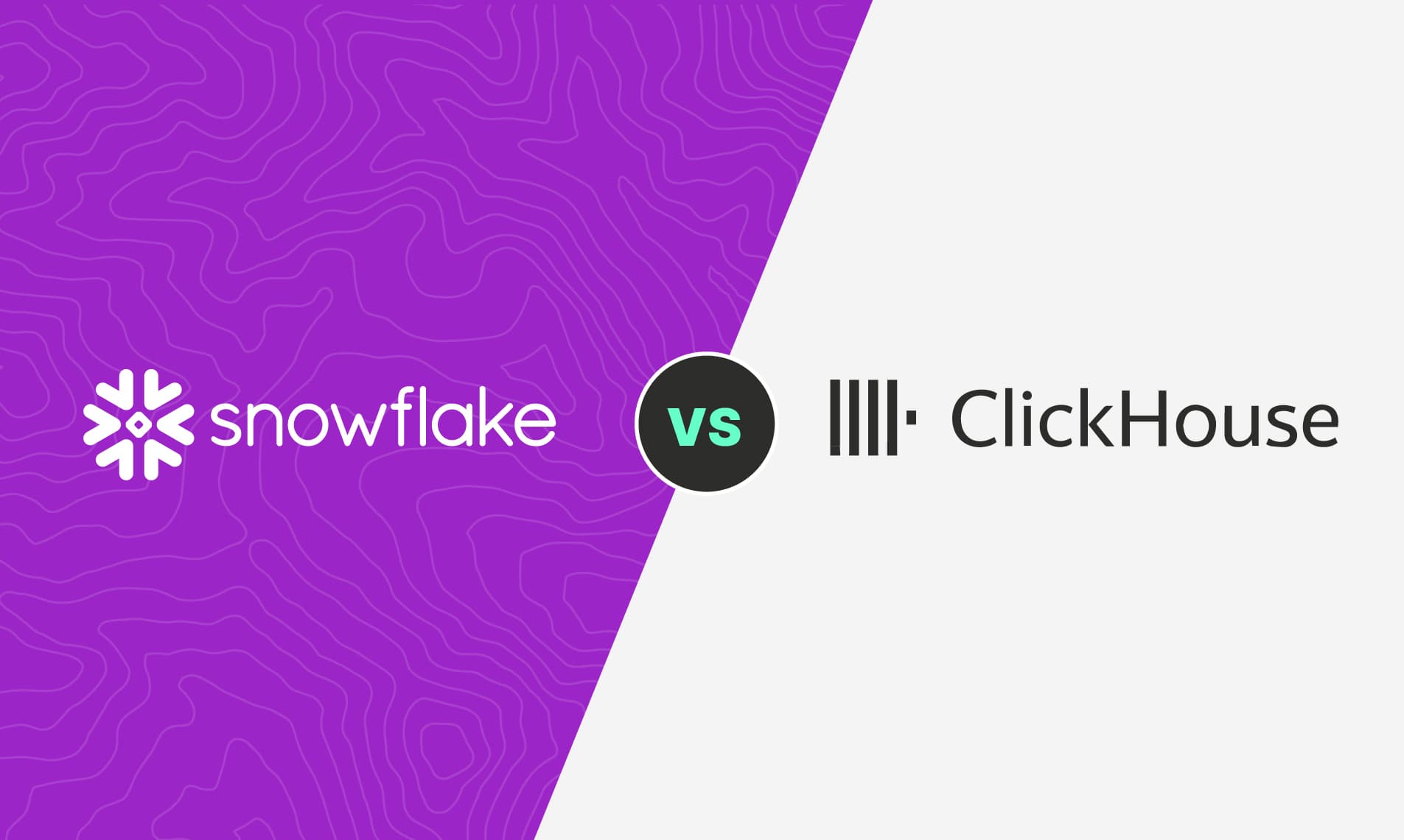Snowflake vs ClickHouse: Pricing Comparison
Compared to Snowflake, you can save big on compute with ClickHouse Cloud. In one scenario, we found 72.3% savings with ClickHouse.

Before ClickHouse Cloud, comparing the cost of ClickHouse vs Snowflake was much more of an apples-to-oranges comparison because ClickHouse only had a self-managed option. Though self-managed models are often cheaper on paper, it can be hard to accurately compare the cost since the cost of maintaining them can quickly add up, not to mention other considerations, like customization vs built-in features. Since fully managed vs self-managed is such a significant factor, the decision often boiled down to choosing a management model rather than simply comparing the services.
Then, in December 2022, ClickHouse announced the General Availability of ClickHouse Cloud. Like Snowflake, ClickHouse Cloud is a fully managed cloud-based database system. Both come with a separation of compute and storage. Although the two platforms mostly cover different use cases, there are some overlapping areas where both can be considered. For certain use cases, ClickHouse offers an attractive alternative to Snowflake, particularly when real-time data processing and cost efficiency are critical. In one scenario, we found 72.3% savings with ClickHouse Cloud.
Note—for brevity, for the duration of this article, when we are referring to ClickHouse, we mean the fully managed service, ClickHouse Cloud.
Snowflake vs ClickHouse Use Cases
Compared to ClickHouse, Snowflake is still more general-purpose; however, as others have pointed out, the gap appears to be closing. Snowflake gained popularity largely due to being one of the first database systems to decouple storage and compute, as well as its advanced features and integrations, such as enterprise-wide data sharing. It's a strong choice for data warehousing, ad-hoc querying, data lakes, and more.
ClickHouse is known for its insanely fast query performance. It excels at high-speed analytics on large datasets. Some use cases are real-time analytics, customer-facing dashboards, and time series data. It continues to add features and is now even competitive with Snowflake for data warehousing.
While Snowflake is still more general-purpose, ClickHouse offers lower costs and higher performance for certain shared use cases. For shared use cases like business intelligence, machine learning, and real-time analytics, ClickHouse is often faster and less expensive than Snowflake. Additionally, ClickHouse's focus on performance makes it ideal for scenarios where low-latency querying is critical, such as monitoring and observability.
Snowflake Price
A common complaint of Snowflake is its pricing is difficult to understand and that costs can add up quickly without a good monitoring strategy. With Snowflake, you are charged for what you use, mostly based on storage and compute. Both storage and compute prices vary based on provider (AWS, GCP, or Azure) and region. There may be additional costs for some optional features and data transfer.
Compute costs are charged by the “credit.” Credits occur mostly in virtual warehouses (aka compute clusters), which can be resized up or down to match the workload. They’re only charged when the virtual warehouse is running, allowing you to save on idle costs. Each warehouse size (shown below, called a “T-shirt size”) has a defined credit consumption rate, representing the resources (vCPU, memory, and temporary storage) used by the warehouse.
Note—Snowflake T-shirt sizes are not public; however, there is strong speculation that on AWS each node is a c5d.2xlarge (except 5XL and 6XL) EC2 instance and similar specifications for the other providers.
Snowflake compute credits with estimated vCPU and RAM (based on AWS EC2 c5d.2xlarge instance). Snowpark-Optimized offers much more memory per node.
Compute costs also depend on the edition—Standard, Enterprise, Business Critical, and Virtual Private Snowflake (customized pricing)—in which "each successive edition builds on the previous edition through the addition of edition-specific features and/or higher levels of service." There is also an option for pre-paid capacity where you can get lower prices for reserving compute; however, we will only focus on On-Demand.
Additional Costs: You may incur additional costs for the following features.
- Data Transfer: You are charged when data is transferred to different providers or regions at the rate of the provider.
- Optional Features: Additional optional features may come at additional compute credits. They can be hard to predict because they run in the background. Some common features are:
- Materialized Views: Materialized Views store pre-computed data, allowing for better performance in query operations. However, they accrue additional compute costs whenever the data is refreshed to ensure it is up-to-date.
- Search Optimization Service: This service improves the performance of point queries, which are queries that seek specific values within a table. It can be beneficial for large tables where searching for individual records might be slow. However, it comes with additional costs due to the resources used to maintain the optimized structure.
- Automatic Clustering: This feature continuously maintains the clustering of specified tables in the background. While it ensures optimal query performance without manual intervention, it can also lead to unpredictable compute costs as the system automatically adjusts the clustering as data changes.
- Cloud Services: Services such as metadata management, authenticating users, etc. You are only charged if daily cloud services consumption exceeds 10% of daily virtual warehouse usage (which is rare).
The cost for the AWS N Virginia (us-east-1) region is as follows:
Snowflake pricing in AWS N Virginia (us-east-1) region
ClickHouse Cloud Price
ClickHouse’s price has some similar pricing dimensions but is much simpler and much more predictable since you are not charged for data transfer or additional features. Costs are separate for storage and compute and both vary based on provider, region, and environment.
Like Snowflake, compute is only charged when active, saving you on idle costs. You also have the option of setting minimum and maximum compute size to scale between.
ClickHouse compute sizes
The cost for the AWS N Virginia (us-east-1) region is as follows:
ClickHouse pricing in AWS N Virginia (us-east-1) region
Snowflake vs ClickHouse Price
We put together a pricing table comparing similar compute sizes for Snowflake Enterprise vs ClickHouse Production in the AWS N Virginia (us-east-1) region. Again, the Snowflake vCPU and RAM are not public by Snowflake, these are assumptions based on community input. Also, the actual performance for specific workloads may vary between services and different amounts of resources may be required for optimal performance.
Snowflake vs ClickHouse pricing cost comparison table in AWS N Virginia (us-east-1) region
As you can see in the pricing table, ClickHouse has significantly less expensive compute across all comparable instance sizes. For example, at the Snowflake 4XL size vs ClickHouse 960 vCPU / 3600 GiB RAM, ClickHouse is priced at about 73% cheaper than Snowflake's cost. Also, The RAM-to-CPU ratio is different between the two services. ClickHouse offers more RAM per vCPU (4-1 ratio) compared to the assumed Snowflake configurations (2-1 ratio).
On the other hand, when comparing storage costs (for compressed data), Snowflake has much lower prices, at less than half the price of ClickHouse's production storage cost. However, it's worth noting that the ClickHouse price includes data transfer, whereas, Snowflake charges you at the rate of the provider.
Also, Snowflake has additional compute costs for features whereas the equivalent (if applicable) ClickHouse features are included for free. This is a disadvantage for Snowflake since the pricing is a lot less predictable. Finally, with Snowflake, certain features require you to use a higher edition, which comes with a higher compute credit price increase.
Snowflake vs ClickHouse Pricing Scenario: Business Intelligence
A medium-sized retail chain wants to implement customer performance dashboards to track and analyze customer transactions, KPIs, and marketing campaign performance across its in-store and online channels. They need daily report generation, interactive dashboards, and the ability to handle frequent data updates and queries from marketing teams.
We'll compare Snowflake Enterprise Edition with ClickHouse Cloud's Production environment. They use AWS in the AWS N Virginia (us-east-1) region. They have 10 TB of storage. The daily active compute time is 12 hours and for their amount of compute they can use either Snowflake's "L" size or ClickHouse's 48 vCPU / 192 RAM (GiB). The monthly cost is calculated as follows:
Snowflake Pricing Calculations
Compute 8 credits per hour x 12 hours per day x 30 days per month x $3 per credit = $8,640
Storage 10 TB x $23 = $230
Total $8,640 + $230 = $8,870
ClickHouse Pricing Calculations
Compute8 compute units x 12 hours per day x 30 days per month x $0.6894 per hour = $1,985.47
Storage 10 TB x $47.08 = $470.83
Total $1,985.47 + $470.83 = $2,456.30
In this scenario, ClickHouse offers a rate of $2,456.30, encompassing compute, storage, data transfer, and features. In comparison, Snowflake's total cost is $8,870 per month (which may be more if there is data transfer outside of the region or use of additional paid features). This results in approximately 72.3% savings using ClickHouse.
ClickHouse provides the necessary functionality for this use case at a significantly lower cost. Not only is ClickHouse more cost-effective due to the lesser price for compute resources, but it is particularly well-suited due to its high performance for real-time data ingestion and querying.
Conclusion
The gap between use cases for Snowflake and ClickHouse is still wide; however, it is narrowing as ClickHouse expands its functionality. For shared use cases, ClickHouse's pricing is extremely competitive, offering much lower prices for compute.
Sign up for a free trial.
Get started with tracking your cloud costs.



